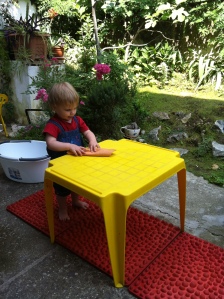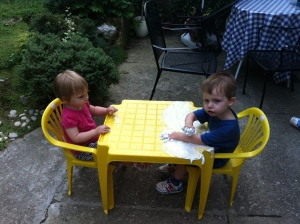Verzija na hrvatskom jeziku (In Croatian language)
Your house or apartment is the place your child knows the best. They will always act a little bit different at home than in the other places. Children whose body schemes are not yet fully developed will feel more relaxed and secured in an environment they know well. So, trying out new activities will work better at home.
We know that when you are at home, you most likely need to take care of the household; laundry, dishes, breakfast, lunch and dinner (especially if your child or other family member requires special diet), cleaning etc. So, you cannot constantly play with your child. That’s ok! However, that doesn’t mean the child cannot get the sensory input they need. Make your home sensory friendly and let the child be drawn to the input they need. Please, make sure you do not overstimulate your child. I cannot emphasize enough how unique each child is and how differently they react to each activity. Even the same child might react to the same stimulus differently at different times. What was fun and amusing in the morning might become the worst enemy five minutes later or by the end of the day. And that’s ok, too! Easier said than done, but all you need to do is observe your child through the sensory glasses.
You can designate a part of your home or child’s room to specific stimulus (tactile, vestibular…). Some parents I work with even made sensory rooms in their basements. This will enable your child to get the sensory stimulus they need easily. However, because the point is to integrate the stimuli, we can always add some spice to it. If your child really wants to swing, rotate or walk on something high, they are most likely looking for some vestibular stimulation. Let them have it for a moment and slowly engage them in another activity, perhaps a song, or some body schema activities or some visual fun.

Permission to post this girl’s photo acquired from her parents.
To be more specific: while your child is swinging have them throw some pillows of different weight into a basket, or have them sing a song in the rhythm of the swing. If you don’t have a swing, you can easily make one out of a blanket and swing your child in different directions, different rhythms and ask your child if they want more. Always wait for their response: a smile, a cry, a yes or a no, or any kind of movement that will indicate their desire to continue or to stop and be respective of it. These activities might be very short and even though you would love your child to swing for 5 minutes, sometimes a swing or two is just enough for them and please respect it. Your child might be sensitive to this kind of stimulation and you do not want to overstimulate them.
If you need to do your chores around the house and the child needs to be on their own for a while, try giving them a small task that you feel they can do on their own, whether in their rooms or with you in the kitchen. Perhaps you can make a line of obstacles through the house or a hallway that the child needs to overcome to get to the kitchen. Make it in a way that you know your child can actually go through it successfully (not too easy, but not getting them to heavy frustrations). You can also incorporate some additional activities, like finding toys and balls and collecting them into the basket in the end of the line. This will give your child sense of beginning and end, it will give them a purpose and ultimately sense of achievement. That’s why it is very important to make the activity challenging enough, but still possible to overcome.
If your child is still too small to be on their own, or you feel it is not safe for them to be alone, you can have them with you:
in the kitchen, they can play with different textures of foods such as beans, cereals, non cooked pasta, or even sticky dough made of water and flour. If you want to go crazy, why not coloring pieces of that dough with food color and have them make something out of it. If you make your dough harder, a good proprioceptive activity is to pluck a small piece, make it a small ball among your fingertips and stick it to a paper in a shape of a line or a circle, heart etc. Of course, have in mind that all these foods can end up in your child’s mouth so make sure they can use it safely and to use those foods they are not allergic to (e.g. gluten, peanuts…)
If you noticed your child doesn’t like to have dirty hands, this next activity will be very challenging and it might take months for them to accept it, but try introducing it little by little: playing with foam. It is a very tactile sensitive texture that a lot of kids cannot stand at first. Usually it happens because the foam doesn’t have proper edges as it is soft and goes through your fingers easily so the brain is having a hard time defining it. It can get scary, too. Some of the children I worked with even wanted to throw up when they touched the foam. So, be slow, go gradually and don’t force anything. You can use the foam on a mirror or glass door to make shapes, prints and drawings. Some children who are less sensitive to taste like to try the foam, so be careful of what kind of foam you give them (shaving foam, whipped cream etc.)

For those kids who are less sensitive to tactile and proprioceptive inputs, try making or buying an uneven surface to put on the floor where your child plays the most or spends the most time. I love this “sandy step factory” product made by a Croatian orthopedic surgeon, dr. Stosic.

http://www.mevjema.com/index.php/proizvodi/ostali-proizvodi/sobna-plaza-detail
You can use your creativity and try making a surface on your own. How about if you used a duvet cover and filled it up with small balls or granulated styrofoam. This is a safe place for your child to jump on (unless the balls are too hard!), walk over, crawl over, roll over or just lay down on. Or just give your bean bags another role.
Check out Making the house sensory friendly post for more ideas!